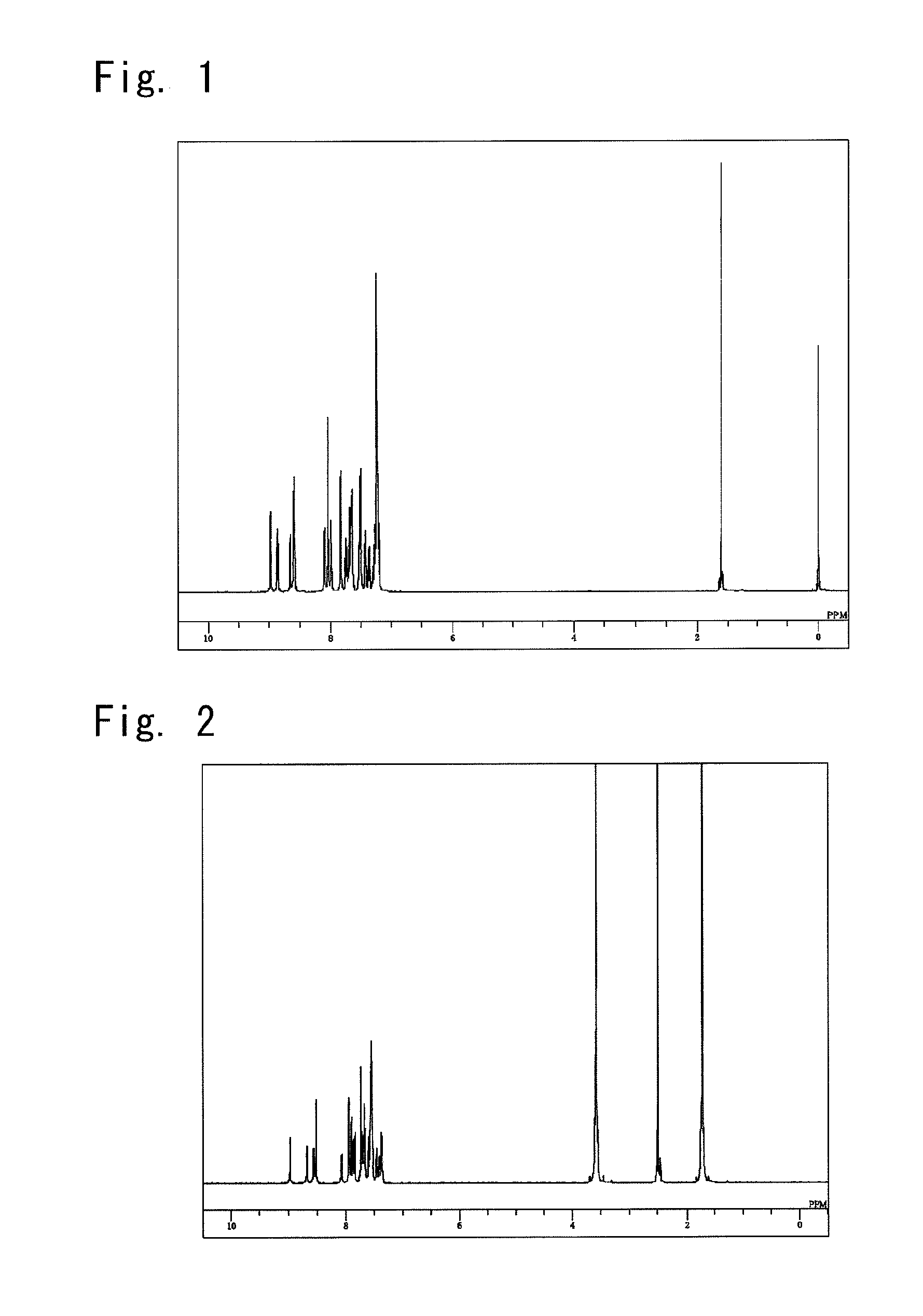Novel naphthotriazole derivatives and organic electroluminescence devices
a naphthotriazole and organic technology, applied in the direction of luminescent compositions, thermoelectric devices, organic chemistry, etc., can solve the problems of low bcp stability, low bcp stability, and bcp efficiency drop, so as to improve electron transport efficiency, high electron injection/migration rate, and high luminous efficiency
- Summary
- Abstract
- Description
- Claims
- Application Information
AI Technical Summary
Benefits of technology
Problems solved by technology
Method used
Image
Examples
example 1
Synthesis of a 5-{10-(naphthalene-1-il)anthracene-9-il}-2-{4-(pyridine-3-il)phenyl}-2H-naphtho[,2-d][1,2,3]triazole
Synthesis of a Compound 9
[0140]
1-Bromo-4-nitrobenzene50 g,3-Pyridineboronic acid31.9g,2M Potassium carbonate aqueous solution309 ml,Toluene200ml,Ethanol40ml, andTetrakistriphenylphosphine palladium(0)11.0g,
were put into a reaction vessel purged with nitrogen, and were heated and refluxed for 14 hours with stirring. The reaction solution was concentrated, and the precipitated crystals were picked up by filtration. Through the dispersion washing with an isopropanol, there was obtained a grey powder of 3-(4-nitrophenyl)pyridine crystals in an amount of 43.5 g (yield, 88.8%).
The thus obtained 3-(4-nitrophenyl)pyridine3.5 g,4-Bromo-1,2-diaminonaphthalene4.0g,Caustic soda1.4g,andToluene50ml,
were put into the reaction vessel purged with nitrogen, and were heated and refluxed for 7 hours with stirring.
[0141]100 Milliliters of toluene was added thereto to extract the reaction so...
example 2
Synthesis of a 5-(9,10-diphenylanthracene-2-il)-2-(4-(pyridine-3-il)phenyl)-2H-naphtho[1,2-d][1,2,3]triazole; (Synthesis of a Compound 74)
[0156]
The second intermediate halide synthesized in 5.59g,Example 1{9, 10-Diphenylanthracene-2-il} boronic acid6.25 g,2M Potassium carbonate aqueous solution14 ml,1,4-Dioxane56 ml,andTetrakistriphenylphosphine palladium (0)0.64g,
were put into the reaction vessel purged with nitrogen, and were heated and refluxed for 4.0 hours with stirring.
[0157]The organic layer was picked up by the separating operation, concentrated under a reduced pressure and was refined by the column chromatography to obtain 6.36 g of a faintly yellowish white powder of 5-(9,10-diphenylanthracene-2-il)-2-{4-(pyridine-3-il)phenyl}-2H-naphtho[1,2-d][1,2,3]triazole (compound 74) (yield, 70.2%).
[0158]The obtained faintly yellowish white powder was identified for its structure by the NMR. FIG. 2 shows the results of the 1H-NMR measurement.
[0159]The following 30 signals of hydrogen...
example 3
Synthesis of a 5-(9,10-diphenylanthracene-2-il)-2-{4-(pyridine-4-il)phenyl}-2H-naphtho[1,2-d][1,2,3]triazole; (Synthesis of a Compound 76)
[0174]
1-Bromo-4-nitrobenzene50 g,4-Pyridineboronic acid31.9g,2M Potassium carbonate aqueous solution309 ml,Toluene200 ml,Ethanol40ml, andTetrakistriphenylphosphine palladium (0)11.0g,
were put into a reaction vessel purged with nitrogen, and were heated and refluxed for 14 hours with stirring.
[0175]The reaction solution was concentrated, and the precipitated crystals were picked up by filtration. Through the dispersion washing with an isopropanol, there was obtained a grey powder of 4-(4-nitrophenyl)pyridine crystals in an amount of 41.8 g (yield, 85.4%).
The thus obtained 4-(4-nitrophenyl)pyridine 3.5 g,4-Bromo-1,2-diaminonaphthalene4.0g,Caustic soda1.4 g, andToluene50 ml,
were put into the reaction vessel purged with nitrogen, and were heated and refluxed for 7 hours with stirring.
[0176]100 Milliliters of toluene was added thereto to extract the re...
PUM
| Property | Measurement | Unit |
|---|---|---|
| voltage | aaaaa | aaaaa |
| brightness | aaaaa | aaaaa |
| work function | aaaaa | aaaaa |
Abstract
Description
Claims
Application Information
 Login to View More
Login to View More - R&D
- Intellectual Property
- Life Sciences
- Materials
- Tech Scout
- Unparalleled Data Quality
- Higher Quality Content
- 60% Fewer Hallucinations
Browse by: Latest US Patents, China's latest patents, Technical Efficacy Thesaurus, Application Domain, Technology Topic, Popular Technical Reports.
© 2025 PatSnap. All rights reserved.Legal|Privacy policy|Modern Slavery Act Transparency Statement|Sitemap|About US| Contact US: help@patsnap.com



